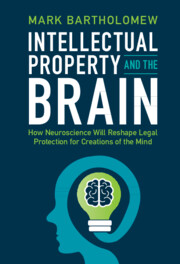 Intellectual Property and the Brain
Intellectual Property and the Brain Book contents
- Intellectual Property and the Brain
- Intellectual Property and the Brain
- Copyright page
- Contents
- List of Figures
- Acknowledgments
- Introduction
- Part I The Law and Neuroscience of Creative Activity
- Part II Understanding Audiences for Art and Advertising
- 3 Neuroaesthetics and Copyright Infringement
- 4 Seeing Design
- 5 Neuromarks
- Part III Using Neuroscience to Improve Intellectual Property Law
- Index
4 - Seeing Design
from Part II - Understanding Audiences for Art and Advertising
Published online by Cambridge University Press: 14 July 2022
- Intellectual Property and the Brain
- Intellectual Property and the Brain
- Copyright page
- Contents
- List of Figures
- Acknowledgments
- Introduction
- Part I The Law and Neuroscience of Creative Activity
- Part II Understanding Audiences for Art and Advertising
- 3 Neuroaesthetics and Copyright Infringement
- 4 Seeing Design
- 5 Neuromarks
- Part III Using Neuroscience to Improve Intellectual Property Law
- Index
Summary
Design patents are meant to promote designs that are “pleasing,” “attractive,” and “beautiful.” Yet judges fret that they will inject their own prejudices into such aesthetic determinations and have adopted a permissive nonobviousness standard that only rejects designs when they are exact copies of what came before. Neuroscience sheds light on the mechanics of design perception and appreciation. Visual processing is arguably the best understood mental process in modern neuroscience. Recent studies show that aesthetic preference is strongly tied to the ease with which an observer can mentally process a particular design. Although a limited amount of innovation may be needed to gain the observer’s attention, consumers insist on simplicity, familiarity, and congruence in designs. Rather than correlating with what an audience considers pleasing, innovation in design, after rapidly reaching an optimal level, begins to trigger aesthetic distaste. I use a variety of examples from popular products and actual cases—like Herman Miller’s Aeron chair and Lego blocks—to illustrate this audience preference for designs in the “aesthetic middle.”
- Type
- Chapter
- Information
- Intellectual Property and the BrainHow Neuroscience Will Reshape Legal Protection for Creations of the Mind, pp. 88 - 101Publisher: Cambridge University PressPrint publication year: 2022
